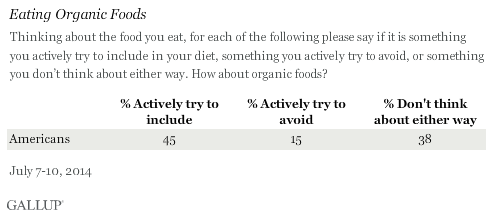WASHINGTON, D.C. -- A little less than half of Americans, 45%, actively try to include organic foods in their diets, while 15% actively avoid them. More than a third, 38%, say they "don't think either way" about organic foods.

Organic agriculture is monitored and certified by the U.S. Department of Agriculture and must adhere to strict regulations to be certified as "organic." Organic food is free of man-made additions like antibiotics, and organic farming is supposed to be better for the environment than traditional farming. Organic foods often cost more than non-organic foods, which could keep some Americans from including them in their diets.
This is the first year Gallup has asked about eating organic foods in the annual Consumption Habits survey. Forty-five percent actively try to include organic foods, putting such foods in the middle of the list of 12 others measured -- trailing fruits and vegetables by a wide margin, but well ahead of fat, soda, and sugar. The 38% who say they "don't think either way" about organic foods is higher than the percentage for any of the other food products.
In the West, Over Half Include Organic Foods in Their Diets
In the U.S., inclusion of organic foods is highest in the West (54%) and lowest in the East (39%). Americans who report living in a big or small city are more likely to eat organic foods than those who describe their location as a town or rural area, 50% versus 37%, respectively, while those who live in suburban areas fall between these two groups.

Younger Americans More Likely Than Older to Eat Organic Foods
More than half of 18- to 29-year-old Americans actively try to include organic foods in their diets, compared with one-third of Americans who are 65 and older. Older Americans are slightly more likely than other age groups to "think either way" about organic foods.

Household income is a factor in food choices, with almost half of upper-income Americans actively including organic foods, compared with 42% of lower-income Americans. Almost a quarter of lower-income Americans, however, actively avoid organic foods, while among upper-income Americans it is closer to one in 10. This could be a reaction to cost, as organic foods typically cost 20% to 100% more than non-organic foods. So lower-income Americans could be actively avoiding organic foods because they are trying to save money on food purchases, rather than avoiding them because of health reasons or dietary preferences.
Implications
Organic foods are subject to strict government regulations in order to earn that title. They can't be treated with chemical pesticides, and growers of organic foods must use natural fertilizers. Often this results in more expensive food, a major downside to organic foods. However, advocates praise organic foods as better for the environment and free of potentially harmful aspects like pesticides and additives. Studies are still inconclusive about whether organic foods are actually healthier.
Given that almost half of Americans actively try to include organic foods in their diets, they may view the benefits of organic foods as greater than their downsides, such as the higher cost or limited access. Income and location appear to be factors in preference for organic foods, although that may be changing. Wal-Mart, the largest retailer and grocer in the U.S., and known for its low-price business strategy, has announced plans to begin selling organic food. Organic food could soon become more easily accessible and more affordable, and this in turn could encourage more Americans to include it in their diets.
Survey Methods
Results for this Gallup poll are based on telephone interviews conducted July 7-10, 2014, with a random sample of 1,013 adults, aged 18 and older, living in all 50 U.S. states and the District of Columbia.
For results based on the total sample of national adults, the margin of sampling error is ±4 percentage points at the 95% confidence level.
Interviews are conducted with respondents on landline telephones and cellular phones, with interviews conducted in Spanish for respondents who are primarily Spanish-speaking. Each sample of national adults includes a minimum quota of 50% cellphone respondents and 50% landline respondents, with additional minimum quotas by time zone within region. Landline and cellular telephone numbers are selected using random-digit-dial methods. Landline respondents are chosen at random within each household on the basis of which member had the most recent birthday.
Samples are weighted to correct for unequal selection probability, nonresponse, and double coverage of landline and cell users in the two sampling frames. They are also weighted to match the national demographics of gender, age, race, Hispanic ethnicity, education, region, population density, and phone status (cellphone only/landline only/both, and cellphone mostly). Demographic weighting targets are based on the most recent Current Population Survey figures for the aged 18 and older U.S. population. Phone status targets are based on the most recent National Health Interview Survey. Population density targets are based on the most recent U.S. census. All reported margins of sampling error include the computed design effects for weighting.
In addition to sampling error, question wording and practical difficulties in conducting surveys can introduce error or bias into the findings of public opinion polls.
For more details on Gallup's polling methodology, visit www.gallup.com.
